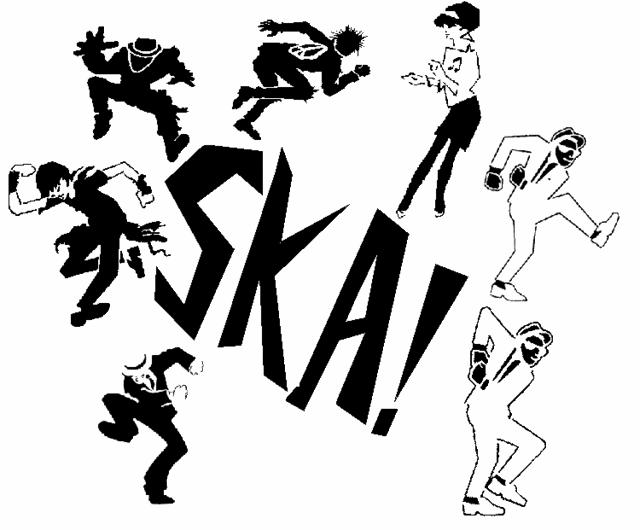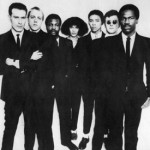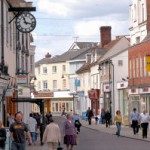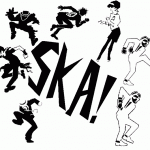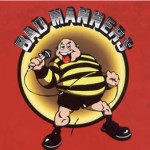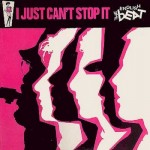Ska, you will recall, is a musical genre with Jamaican roots related to reggae and rocksteady. As Wikipedia sums it up:
“The style was of bars made up of four triplets but was characterized by a guitar chop on the off beat – known as an upstroke or skank – with horns taking the lead and often following the off beat skank and piano emphasizing the bass line and, again, playing the skank.[1] Drums kept 4/4 time and the bass drum was accented on the 3rd beat of each 4-triplet phrase. The snare would play side stick and accent the third beat of each 4-triplet phrase.[1] The upstroke sound can also be found in other Caribbean forms of music, such as mento and calypso.”
But to the audience, this meant skanking as a dance form in time to the beat, with the characteristic break, not dissimilar to the pause following a riff in many rock songs. The rhythm is irresistible – you can’t keep still to a ska song, even if it’s only tapping your feet and nodding your head in time to the beat. Not hard to see how it became so popular!
Like many fashions, it has gone through many twists and turns, sometimes wildly trendy, at other times forgotten and neglected. The original 60s wave won a keen cult following, but it was the British Two Tone revival that struck a chord with me. Coming hot on the heels of the punk revolution there was New Wave, New Romantics and Ska. Of the three, ska always struck me as the most fun, but I could also identify with it closely since many of the bands originated in Coventry, where for my sins I was born. Much more than that, lyrically it engaged in social commentary almost unknown. Ska reflected the mood of the nation. Two examples among many: the Specials’ Too Much Too Young hit a raw nerve (and actually got banned from Radio 1), and Ghost Town‘s mournful deconstruction of Coventry at the time of rioting on the streets spoke for a generation.
The bands at the time were an explosion of musical innovation and excitement. The Specials led the way with Gangsters, though quick on their heels we had The Beat (actually on a label called Go-Feet rather than Two Tone), The Selecter, Madness (from London), Bad Manners, the all-female Bodysnatchers and several more. I saw several ska gigs, mostly pub bands though there was an unforgettable night in the early 8os watching the Selecter at Lancaster Uni, where I was visiting friends. The band was best known for singles like On My Radio and Three Minute Hero (actually 3 minutes, 3 seconds), though their range extended into more interesting territory. In fact, one staple of many ska bands was the application of a ska beat to well-known melodies: Selecter followed the Skalites in a brilliant ska version of the James Bond theme, Byron Lee and later Bad Manners did Elizabethan Reggae, Madness did Swan Lake and so on.
Typically, Two Tone described these bands and audiences to a tee: multi-racial and influenced by a wide range of sources. The music drew everyone together in a happy mix, which surely is what good music ought to do.
* * *
Bocking Arts Institute in the sleepy market town of Braintree, Essex, is hardly the venue you would expect to launch a major revival of the ska era. It sounds like the sort of place you would go to visit a WI meeting about crochet or a speech from a local dignitary about his recent trip to Aberystwyth. The acoustics are far from perfect and facilities are basic (love the hand-written sign over the bar, basically a hole in the wall over to one side of the auditorium.) Not a dive like some of the legendary clubs of the past, in fact quite respectably suburban. The building has an interesting history, though I can’t find it by Googling, so that must come another time.
Anyway, my first trip to this august venue came when I spotted that that The Selecter were appearing there on my then girlfriend’s birthday, so it really was too good to miss. The band had suffered a major split in the early 80s, after which singer Pauline Black forged a career as children’s TV presenter, but the band reformed from 91 to 2006 to exploit the ska nostalgia market, but Black and fellow vocalist Arthur “Gaps” Hendrickson reunited in 2010 for true current round of tours by trademarking the name to distinguish from guitarist Neol Davies’s version of the band. This fragmentation seemed to afflict many ska bands, with The Beat vying for attention from Dave Wakeling’s English Beat, and the Specials doing battle for a time with the Special AKA. A sad way to end, you might say, but evidence that there is much mileage in the nostalgia market.
After a youngish ska support band did their act with an appalling sound mix that brought out the worst of the acoustics of the hall, The Selecter appeared to great acclaim. Credit to both Black and Gaps – they looked and sounded brilliant (Gaps began wearing suit, tie and hat, and finished off stripped to the waist to display a fine physique for a man of around 58!).
The band played their hits and more. A professional show much loved by an audience dominated by middle-aged and balding men who were having a ball. One guy, there with his wife, went wild to the James Bond theme, pointing an imaginary gun in iconic poses to the beat. His wife meanwhile pretended she did not know him! Everyone went home very happy, including those few who looked way too young to have appreciated the Two Tone revival.
All well and good – and then I spotted the next gig: The Beat were coming to town. Compared to The Selecter, The Beat were arguably truer to the reggae roots of Ska but also had an edgier sound, aided by the saxophone sound of an authentic Jamaican, Saxa. Saxa (AKA Lionel Martin) was at 49 comparatively old when the band started out, but he had played with all the greats (Desmond Dekker, Prince Buster and even the Beatles!) His playing had a distinctively dry tone that made the Beat songs stand out from the crowd. Saxa has long since retired, and what became of Son of Saxa, who replaced him in the band, I know not. However, the current saxophonist with the band, a young white chap whose name eludes me, had picked up the style and was carrying in the fine tradition established by Saxa.
This time I went with my friend Elaine, who took me to see a rather dull gig on her birthday (Midge Ure solo acoustic set), so I promised to get her dancing at the Beat gig! First thing to note is that there are just two original members of the band in this manifestation. Luckily, they are singer Ranking Roger and drummer Everett Morton, ever the driving force behind Beat songs. Roger looked every bit as good as Pauline Black and Gaps Hendrickson – slim, lithe, energetic, a fine head of long braided hair, and in excellent voice. He shared vocal duties with Ranking Junior, who did the dub sections Roger used to do when Wakeling provided most of the lead vocals.
The singalong hits kept coming and coming, culminating in a 10 minute extended version of Mirror in the Bathroom. Of highlights there were many: a ska-ified Rock the Kasbah; Tears of a Clown; Ranking Full Stop and many more. Today I played my vinyl copy of the first Beat album, and realised they had played about 8 tracks from it, and on merit too. An excellent evening’s entertainment that rolled back the years. Elaine and I enjoyed, indeed could not help dancing to the songs, and even found that after nearly 30 years the skanking just came naturally!
However, Braintree’s new-found reputation as home to ska did not stop there. The next band to play at that venue is in May: Bad Manners!! Flushed with that good news, we wandered back through the centre of town, past a pub called the Swan. Right by the window as we passed, a young band was playing live. The song they were performing as we walked past was, you guessed it, the Specials song Gangsters.

